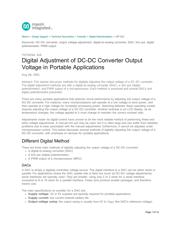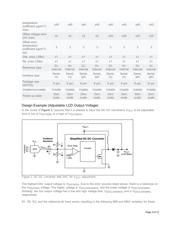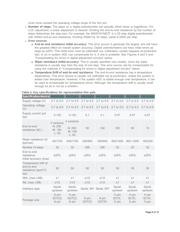下载

Maxim > Design Support > Technical Documents > Tutorials > Digital Potentiometers > APP 818
Keywords: DC-DC converter, output voltage adjustment, digital-to-analog converter, DAC, trim pot, digital
potentiometer, PWM output
TUTORIAL 818
Digital Adjustment of DC-DC Converter Output
Voltage in Portable Applications
Aug 06, 2002
Abstract:
This tutorial
discusses methods for digitally adjusting the output voltage of a DC-DC converter.
The digital adjustment methods are with a digital-to-analog converter (DAC), a trim pot (digital
potentiometer), and PWM output of a microprocessor. Each method is assessed and several DACs and
digital potentiometers presented.
There are many portable applications that optimize circuit performance by adjusting the output voltage of a
DC-DC converter. For instance, many microprocessors can operate at a low voltage to save power, and
then operate at a high voltage for increased processing power. Switching between these operating modes
requires adjusting the output voltage of a DC-DC converter. Another example is an LCD display; as its
temperature changes, the voltage applied to it must change to maintain the correct contrast ratio.
Adjustments made via digital control have proven to be the most reliable method of performing these and
other voltage adjustments. A manual trim pot may be used, but it is often large and can suffer from reliability
problems due to wear associated with the manual adjustments; furthermore, it cannot be adjusted under
microprocessor control. This article discusses several methods of digitally adjusting the output voltage of a
DC-DC converter, with emphasis on devices for portable applications.
Different Digital Method
There are three main methods of digitally adjusting the output voltage of a DC-DC converter:
A digital-to-analog converter (DAC)
A trim pot (digital potentiometer)
A PWM output of a microprocessor (MPU)
DACs
A DAC is simply a digitally-controlled voltage source. The digital interface to a DAC can be either serial or
parallel. For applications where the DAC update rate is fairly low (such as DC-DC voltage adjustments),
serial interfaces are typically used. They are smaller, using only 2 or 3 wires for a serial interface,
compared to 8 to 16 wires for a parallel interface. Fewer pins produce smaller packages, and therefore
lowers cost.
The main specifications to consider for a DAC are:
Supply voltage: 3V or 5V supplies are typically required for portable applications.
Supply current: low current extends battery life.
Output voltage swing: the output swing is usually from 0V to V
REF
(the DAC's reference voltage).
Page 1 of 12








